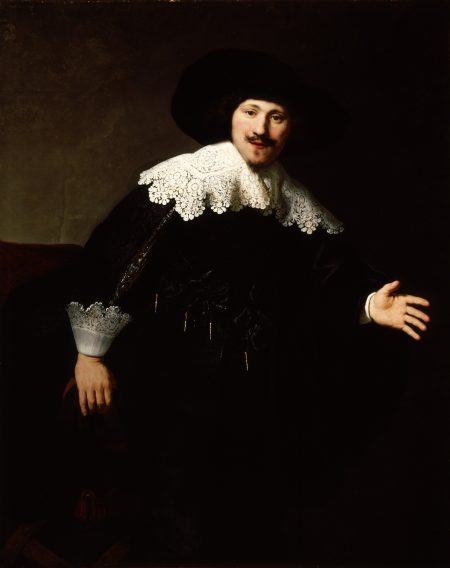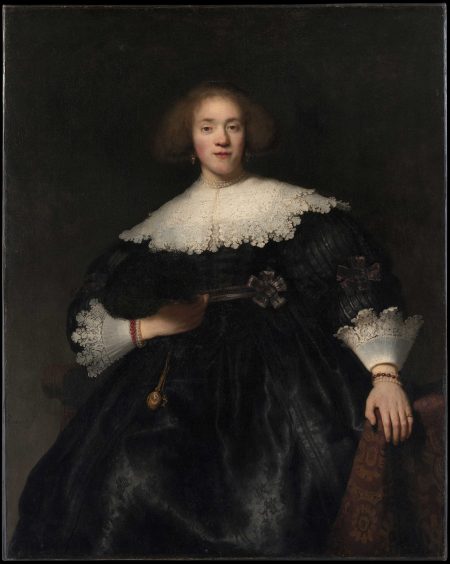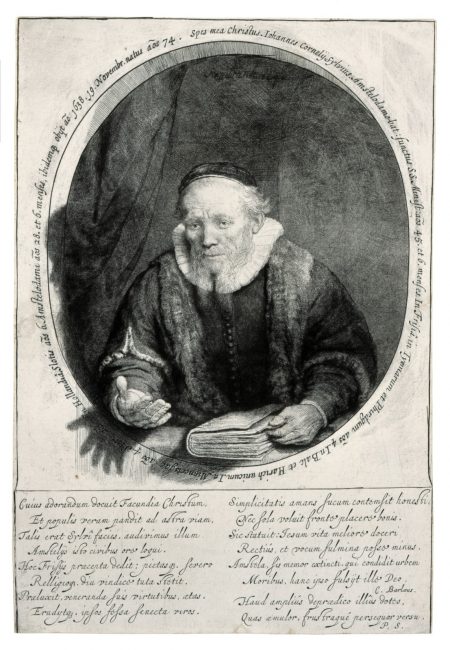The High Renaissance portrait sought to depict dignity—the sense of worthiness that was, typically, an even more valuable quality in a portrait than likeness—in repose. The great 16th century portraits tried to capture what was least changing about their subjects. Though the period knew, of course, that human beings were subject to time, they assumed that portraits were designed to avoid planned obsolescence, and often counted on them to defy time. Sometime in the 1570s, for example, England’s Queen Elizabeth I settled on a portrait type that was then continually reproduced and copied over the final three decades of her life with her face and hair virtually unchanged even as she aged, despite getting wrinkled and losing her hair, in what has come to be known as the “mask of youth.”
This was not the case for Baroque portraiture. The 17th century changed its vision of art, its vision of what it meant to look and behave like a human, and the relationship between the looked-at painted object and the onlooker. One of the finest Baroque portraits to be found in Cincinnati is Rembrandt’s “Portrait of a Man Rising from his Chair” (1633) at the Taft Museum of Art. He looks out directly at us as he pushes off his chair to stand up, dressed in black silk with elaborate white lace cuffs and collar, one hand out in greeting. He is caught in mid-rise, a moment frozen in time. His chair is a sort of launching pad. Just how old is he? These things can be hard to tell; when the painting was still in the collection of Charles Taft, before there was a Taft Museum, it was exhibited under the title “Portrait of a Young Man Rising From a Chair.” Now it’s just a “Portrait of a Man Rising.” His face indeed looks young; the hand resting on the arm of his rather plain wooden chair (though discretely covered in red velvet) looks older. His hair is lustrous and slightly curly; his moustache is slightly turned up at the ends; his beard is neatly combed but sparse; and he sports what no less dignified a source than the Rembrandt Database calls, in its index of searchable terms about the painting, a “soul patch.” Like many Baroque portraits and certainly like most of Rembrandt’s, his face swims towards us coming out of the dark into the light; there is a heliotropic quality to his portraits, which perhaps may suggest that Rembrandt got from painting the human face and body what many of his contemporaries sought in painting tulips.
If the High Renaissance hoped to capture the man, the Baroque sought to capture the moment. For the 17th century, every human truth passed very quickly, seguing into the next. It is interesting to compare Rembrandt’s “Young Man Rising” with Anthony Van Dyck’s portrait of “Lucas van Uffel,” at the Met, done about a decade earlier than the Taft’s Rembrandt (c. 1622). He is also in black, also wearing white lace cuffs and collar, and is also rising from his chair to greet an audience. In some ways, he presents himself to us less formally; he is not wearing a hat and his hair is in disarray across his forehead as if he had just run his fingers through it to neaten up for his visitor. But in other ways, the portrait is more formal, more in line with the great portraits of the previous decades which surrounded a man with his attributes, which in van Uffel’s case include mathematical tools, a globe, a statue, a drawing. (He was, among other things, a distinguished early art collector.) This is his world of the mind, which he shares with those fortunate enough to have been allowed to interrupt him. His world is made up of these things. The Taft’s portrait is less patriarchal, however agreeably and impressively so van Uffel’s likeness may be. It is almost surely one of a pair of portraits, with the painting of his wife now at the Metropolitan, where she goes by the name of “Portrait of a Young Woman with a Fan”; from time to time, they are exhibited together, with the man on the woman’s right, indicating that they are a married couple. In some descriptions, she is rising too, though with less drama. Walter Liedtke, the Met’s Curator of European Painting, observed a few years ago when the two portraits were most recently reunited that she too is starting to stand up but is more “gently rising,” “more reposed,” where he seems like “he’s been shot out of this circus cannon.”
For the pioneering portraits of the Baroque era, drama is everything. The Taft’s painting dates to the first years Rembrandt spent in Amsterdam, the capital and economic center of the Netherlands, having just moved there from the much more sedate Leiden. It is generally felt that in paintings like this, Rembrandt is consciously leaving a more conservative set of artistic conventions about portraiture behind. The picture was done around the same time as his stunning “The Anatomy Lesson of Dr. Nicolaes Tulp” (1632). The dynamics of the figure in the Taft painting were probably something he learned from the historical and group paintings Rembrandt had worked on as his career was starting, where narrative and individuality is everything. The emphasis was on capturing the look of a psychological moment before it has shifted almost imperceptibly to something else. (I think that this emphasis on capturing a thing just as it was changing has some kinship with calculus—or what I remember of it—invented by Sir Isaac Newton in the mid-1660s, when he was undergoing social distancing as a result of an outbreak of the Plague.) This aesthetic was also almost surely influenced by the rise of the theater and theatricality in the 17th century, which saw the world in terms of poses, striking if fleeting expressions, and a more active and assertive relationship between a portrait’s subject and their audience.
If High Renaissance portraiture is designed to engender respect on the part of the viewer for what they are being allowed to witness, the audience for a Baroque portrait is likely to find that they’re being addressed directly, and even made complicit. In Jusepe de Ribera’s amazing “Martyrdom of St. Bartholomew” (1644), the dying saint ignores his ghoulish tormentors to look directly out at the onlooker. Are we being designated as witnesses assigned to carry the story with us, or to share the guilt for allowing such things to happen? This becomes connected to a formal issue in 17th century painting about the space depicted in a painting. In the 16th century, the subject being painted is generally contained comfortably within a relatively shallow space, even if there is a landscape backdrop behind. By contrast, the 17th century portrait comes forward and may even seem to break the picture plane, reminding us that pictorial space is an illusion that can be punctured. In Rembrandt’s “Girl in a Picture Frame” (1641), a young girl rests her hands on the bottom of a painted frame, a trompe-l’oeil that suggests that she could climb right out of her painted space into our dimension. In his etched portrait of Jan Cornelius Sylvius (1646)—which can be seen on the Cincinnati Art Museum’s online exhibit about “Rembrandt: Master Printmaker”—the subject reaches his hand out beyond the oval that surrounds but cannot contain him; his Bible and his profile cast shadows that extend beyond the frame as well. The Taft’s “Man Rising” makes more modest attempts to penetrate the illusion of the flat pictorial space. His welcoming hand comes out towards us. In the pendant portrait, the young woman holds a fan that is pointed away from her chest directly at us.
The Taft’s “Man Rising” is the sole survivor, attribution-wise, of the four paintings that used to be exhibited in Cincinnati as Rembrandts when I came to town in 1974. The Taft’s painting was the best known of them (though, as we shall see, not the most notorious). When Charles Taft originally bought the painting, it was an event noteworthy enough for the New York Times on August 7, 1909 to cover the sale with a full column story. The headline read: “Chas. P. Taft Gets Famous Rembrandt,” and the sub-head was “President’s Brother Now Has One of the Four Best American Private Art Collections.” Back in the 1970s, the Cincinnati Art Museum was showing “Young Girl Holding Out a Medal on a Chain” as a Rembrandt, which is now considered to be a 17th century copy. (It was sold to Mary Emery by the same New York dealer who sold “Man Rising” to the Tafts.) The Museum still has a major collection of more than 80 of his prints which formed the basis for the 2006 show on Rembrandt’s prints which has been distilled into the online exhibition. The Taft also exhibited two additional oil paintings with Rembrandt’s name on their labels, an unpleasant and unlikely picture of an old woman and a much more interesting picture of a mature man leaning on a window sill with a tired but knowing twinkle that used to be categorized among his self-portraits. These last two also made the New York Times when, on December 18, 1973, they were stolen from the Taft. The story is featured prominently in Anthony Amore and Tom Mashberg’s 2011 book, Stealing Rembrandts, which discusses the 40 or so Rembrandt oils that have been pilfered from museums and collections over the years, including one painting—now generally referred to as the “Takeaway Rembrandt”—that has been stolen four times since 1966. Though there is a certain romance about the theft of paintings so well known that they can never be sold on the open market (the 1962 movie Dr. No featured the stolen portrait of Wellington by Goya as having a place of honor on an easel in Dr. No’s hideout), the actual details often turn out to be a good deal more tawdry. In this case, the pictures were nabbed by a group of three men in their 20s from Loveland, including the owner of the Speak-Easy Nightclub, who ended up offering to return the paintings to the Museum for a ransom. They decided that they would only deal with WCPO’s news anchor Al Schottelkotte as an intermediary, who received one of the missing pictures wrapped in a blanket at the Regis Lounge near Cheviot. In the end, the thieves were caught, and all the hundreds of thousands in ransom money was recovered except for $27 that the men had spent celebrating their heist at a local Frisch’s. The paintings were returned to the Taft only to be subsequently downgraded—as were a great many paintings in this country and abroad initially and optimistically purchased on the basis that they were thought to be authentic Rembrandts—and are no longer on display.
There have never been questions raised about the “Young Man Rising.” The work seems unquestionably in the style of young Rembrandt, with short and tiny brushstrokes, rather than the bravura brushwork of his later work. Rembrandt’s peer Frans Hals went on to make a career from his extravagant and magnificent brushwork portraits; the Taft owns several of these as well, including the well-known standing (or rather, slouching) portrait of brewer Michiel de Wael. With one hand on his hip and the other holding his leather gloves, he looks at us with what I take to be a mixture of sharing a joke with us and condescension. He knows things that we don’t, and he’s fine with that. By contrast, Rembrandt’s “Man Rising” has an expression that is both lucid and opaque. There is a bit of extravagant blankness to his look, perhaps because we have come a upon him unexpectedly, and he is surprised, or in the process of composing himself, or getting ready to say something gracious and appropriate to us. There is a moonish innocence to his expression, though it also looks a bit like we have come upon him doing something he didn’t intend for us to see. He seems less worldly than de Wael.
And yet the portrait is very much about his worldly status. His costume looks minimal, even severe: nothing but black and white. On the surface, it seems like a portrait of the essence of severe Dutch mercantile Protestantism. There is no color because the portrait is designed to celebrate plainness and dignity and—by implication—an active spiritual opposition to ostentation and display. But a harder look suggests that in addition to sobriety, this is a portrait designed to suggest substantial wealth. Across his chest are a series of elaborate silk rosettes with metal decorations hanging from them. As for his collar, starting around the second decade of the 17th century, ruffs were out. The people who could afford them were all wearing fine imported lace collars and cuffs. A closer look reveals that even the plain black silk isn’t plain: there is a jacquard floral pattern, in what was generically thought of as the French fashion. The black dyed silk that we take for granted in Dutch portraiture was an expensive fabric. To make a good black silk, you first dyed the fabric blue, typically with indigo, so that it doesn’t end up looking brownish. The black pigment layered over the blue came from logwood, a tree found only in Central America. In the 17th century, all of Central America was nominally Spanish territory, so logwood reached the Netherlands by a tenuous and risky route. The Dutch established temporary timbering camps along the coast of the Spanish New World, aware that they were vulnerable to raids by Spanish privateers. In response, the raided Dutch might link up with pirates to counterattack the Spanish, driving costs and prices up—all just to get the right color black. Plainness is a luxury commodity. It’s often true that seventeenth century Dutch culture wanted it both ways. We see this in their wonderful still lifes, where we are sometimes asked to believe that fresh lobsters on a polished pewter platter are merely a sign of sinful excess and a beautiful and expensive gold watch is merely a reminder of the medieval conviction that mortality is the great equalizer.
There are few artistic movements that depict domesticity as evocatively as the Dutch Golden Age. There are paintings that allow us to see inside practically every sort of middle class living space: courtyards, the fireplace below for cooks and servants, sitting rooms, rooms for music lessons, bedrooms for women to flirt with their doctors, dining rooms with their groaning boards heaped with all that luxurious food whose appeal—nominally—we are expected to see through, and living rooms where we can see the luxuries of middle class life. There we find beautiful glass windows, curtains, tiled floors, comfortable furniture, and paintings on the walls. But the “Man Rising from his Chair” is not actually in any of those spaces. As best we can see, he is sitting in front of a blank, gray wall that seems to have a modest crack in it. We have reason to believe that the pair of paintings—the Taft’s rising man and the Met’s rising young woman—hung close to each other but were slightly separated, perhaps by a door or by a substantial piece of furniture. They are located in a domestic space, but no domestic space is actually shown. We are being welcomed—perhaps enthusiastically, perhaps with some surprise—to a world kept concealed from us.
There is a quality in the Rembrandt painting that ushers us into someone else’s space, but also keeps us out. We are forever in a kind of vestibule. As the man rises to greet us, the painting allows him to keep the privacy of his house, his possessions, and his arrangements intact. He is both our host and a sentinel. His domestic space is too important to violate or share. Like many of the greatest portraits, he is inviting us in, and keeping us out.








